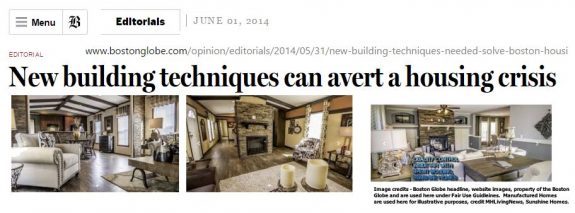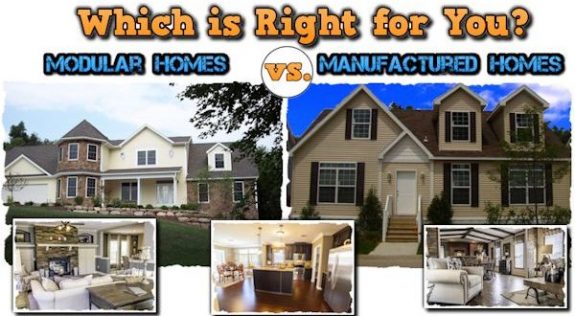In a Boston Globe Editorial dated June 1, 2014, one of the nation’s largest newspapers’ digital edition carried the following article, which advocated for manufactured and modular housing to be used in their city.
We’ll share the entire column, under fair use guidelines, and then comment at the end.
Their headline and article (from their page linked here) is found below, between the — dashed lines.
—
THE TERM “manufactured housing” tends to invoke a 65-by-12-foot mobile home plopped down in a trailer park. But the industry has evolved to the point that many housing units assembled in factories are indistinguishable in looks and quality from homes built on site. Multi-family, modular homes built to federal safety standards would look especially good in Boston neighborhoods where middle income people are increasingly priced out of the market. The modular building industry cites cost savings of 10 to 20 percent as compared to conventionally built homes. Those savings would open a lot of doors.
Last week, Mayor Walsh vowed to come up with a comprehensive plan to address the city’s chronic lack of middle-income housing. Many officials consider this housing problem to be biggest single threat to Massachusetts’ economy. At a time when manufacturing businesses are growing again, and even pillars of the knowledge economy require livable options for their back-office workers and support staff, the Boston area is almost totally unaffordable to the middle class. Subsidized-housing programs can only do so much. Walsh needs to look at market-driven solutions. A new zoning initiative to identify key spots in Boston neighborhoods for multi-unit developments would be a good start. But in seeking to drive down construction costs, manufactured housing must be encouraged, as well.
Traditionally, the building trades — which were formerly headed by Walsh himself — have pushed hard for so-called stick-built construction over less-expensive manufacturing techniques. Construction workers may well resent the sight of entire walls with doors and windows intact arriving in Allston, Hyde Park, Dorchester, or other Boston neighborhoods on flatbed trucks from out-of-state factories. But there is room for a workable compromise, and Walsh is in a good position to negotiate it: Manufactured homes could be built in Massachusetts factories with unionized labor. Then, as more area communities take advantage of the economies of scale, construction prices would drop even further. The need for new mid-priced units is vast throughout eastern Massachusetts; in the city of Boston itself, some 30,000 of them need to be produced over the next decade just to meet existing demands.
The Walsh administration, like the Menino administration before it, rightly worries that Boston is becoming a bifurcated city where the very rich live in market housing and the very poor live in subsidized units. And once that happens, much of the city’s character goes out the window. The South End, Charlestown, Back Bay, Fenway, and other northern sections of the city are considered beyond reach for families who are not prepared to spend at least $3,500 in rent. In downtown Boston, according to a recent analysis, a family earning $80,000 annually could afford just 1.7 percent of the homes sold.
The price of new housing can be reduced in two ways: By streamlining the approval process and reducing the cost of construction. A concerted effort to rezone Boston’s neighborhoods would ensure that local opposition to multi-unit developments would be resolved before the projects are actually on the table, greatly reducing delays and giving developers and the banks who finance them far greater certainty.
For their part, developers will have to utilize less-expensive construction techniques. Mid-rise construction, for example, is being used increasingly to alleviate housing shortages in cities with high housing costs. The new model calls for the construction of wood-frame, code-compliant buildings of up to five stories on a base of steel and concrete. Choosing wood over steel as the major structural material can represent savings of 10 percent or more in hard costs and significantly reduce construction times, according to industry analysts. And the framing technique is sufficiently versatile to allow for the construction of dozens of housing units on modestly sized sites.
In the early 20th century, triple deckers became the symbol of Boston’s striving middle class. The construction style maximized living space on small, rectangular lots. In the early 21st century, the new symbol of middle class housing could be modular homes or reasonably-priced condos and apartments built in wood-frame structures above retail outlets. It would help preserve middle-class life and keep Boston one of the nation’s most vibrant cities. ##
—
I can’t get too deeply into Boston’s politics, the Globe’s editors will have a superior experience in their city than what I might offer, beyond saying that what they describe is rather common in many major U.S. cities. Union labor in often Democratically controlled cities chocking off the prefab/modular/manufactured home options are one reason why housing costs are so high.
But the Globe suggested a solution for that issue.
Land use – zoning related issues – are another factor that drives up housing costs.
While striving to navigate their own realities, the Boston Globe’s editors nailed a number of facts that ought to be carefully considered on this, the 40th anniversary of the birth of federally regulated manufactured housing.
As factory-built home industry pros know, today’s manufactured homes evolved from – but are not – the mobile homes of yesteryear.
Yet as the Globe’s editor’s wisely noted, many think of factory building in terms of those older trailers from roughly the 1930s to the 1950s, and the mobile homes from the 1950s to the mid 1970s. The video below illustrates that evolution, and the original article with that video is found linked here.
Others may have experienced only entry level manufactured housing, which while important to millions, ought to be understood as just one of the ways manufactured homes can be provided to the public, since residential style manufactured homes can rival the looks and quality of conventional housing for about half the price.
The Solution is Hiding in Plain Sight
In cities, suburbs and towns across America, there is a growing need for quality affordable living. Federally regulated and preemptive manufactured housing is an obvious solution for millions, and somewhat more costly modulars could work well in other municipal settings.
The false impressions about those off-site building construction options can be cleared up in part by sharing videos and stories, like those linked on this page and so many others that are found on MHLivingNews.com.
One example of an informed household – an engineer and his professional wife – who opted to buy a manufactured home – illustrates that the trailers of old have evolved, just as bag phones evolved into modern smart phones. See that video linked from the image below.

But other steps need to compliment videos. Factory tours along with tours through residential style neighborhoods that look like other houses but are built in a factory, all of those steps should be part of the process of making manufactured homes the acceptable and embraced choice by home seekers and public officials alike.
Until manufactured housing professionals – in concert with the public officials, housing professionals, forward thinking MH industry leaders and a public that needs to be exposed to the wonders of today’s manufactured housing – pull together and act, tens of billions in economic opportunity are being lost every year.
Those opportunities would create good jobs, as the Boston Globe correctly points out. It could reduce the pressures on subsidized housing programs too.
Embracing the manufactured and modular home systems of building can restore the American Dream of home ownership that is appealing, eco-friendly and affordable. May the Boston Globe’s thoughtful column cause others across the nation to give this issue some serious thought that leads to action that yields mutual victories for all involved. ##

By L. A. ‘Tony’ Kovach. Tony Kovach is nation’s leading publisher, consultant, trainer and expert witness leading to the rebirth of safe, appealing, affordable and eco-friendly modern manufactured homes. Tony is a proud part of the team that publishes MHLivingNews.com and MHProNews.com, divisions of LifeStyle Factory Homes, LLC.


